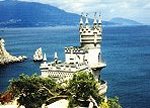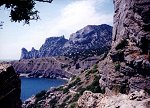LANA'S TOUR: SIGHTSEEING TOURS IN THE CRIMEA, UKRAINE
Make your trip to Russian Riviera" safe and exciting!




Crimea
|
LANA'S TOUR: SIGHTSEEING TOURS IN THE CRIMEA, UKRAINE Make your trip to Russian Riviera" safe and exciting!
Crimea
|
|
The southern coast, protected by the mountains, has a mild climate. The Crimea covers an area of 27,000 square kilometers.
The major cities are Simferopol (the capital), Sevastopol (the base of Russian and Ukrainian Black Sea Fleet), Yalta and Evpatoria (major tourist areas), Bakhchisaray (the capital in 14-15th centuries), and Kerch (industrial center). The population of the Crimea was 2,550,000 in 1991, consisting of Russians (65%); Ukrainians (22%); Crimean Tatars (10%); and Belorussians, Armenians, Greeks, Germans, and Karaims (3%). The Crimean coasts are washed by the Black Sea, except on the northeast where it is bordered by the Sivash or Putrid Sea, a shallow lagoon separated from the Sea of Azov by the Arabat spit of sand. The shores are broken by several bays and harbors. The southeast coast is flanked from the sea by a parallel range of mountains with alpine meadow plateaus, and these are backed inland by secondary parallel ranges, making three ridges.
The main range of these mountains rise up with extraordinary abruptness from the deep floor of the Black Sea to an altitude of 2000 to 2500 ft.
A number of short streams, none of them anywhere navigable, leap down the flanks of the mountains by cascades in spring: the Chernaya, Belbek, Kacha and Alma, to the Black Sea, the Salghir, with its affluent, the Kara-su, to the Sivash lagoon. In point of climate and vegetation, there exist marked differences between the open steppes and the south-eastern littoral with the slopes of the Main Range of the Crimean mountains behind it. In winters, the tops of the mountains are covered with snow, but snow seldom falls to the south of them and ice, too, is rarely seen in the same districts. The heat of summer is moderated by breezes off the sea and the nights are cool and serene. The winters are mild and healthy. Dense fogs occur sometimes in March, but seldom penetrate inland. The narrow southern strip of coast and the slopes of the mountains are smothered with greenery. This Russian Riviera stretches all along the south-east coast and is studded with summer sea bathing resorts: Alupka, Yalta, Gursuf, Alushta, Sudak, Feodosia. Cities, spas, villages, mosques, monasteries, palaces medieval fortresses are nestled amongst the woods of hazel and other nut trees, the groves of bays, cypresses, mulberries, figs and olives, the vineyards, and tobacco plantations. Gardens are filled with many varieties of flowers.
The higher slopes of the mountains are thickly clothed with forests of oak, beech, elm, pines, firs and other Conferee.
|
|
Contact person: LANA SMITH. |